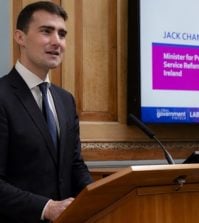Mathew Duncan, Finance Director of Crossrail 1, UK: Exclusive Interview

Working on the vast project to build a fast new railway line 100km across London, Mathew Duncan’s team of finance professionals are proving that the public sector can bring in major infrastructure schemes on time and on budget. Dawn Cowie asks Duncan how he’s kept the programme on track
“Nothing stays still for long on a project like Crossrail,” says Mathew Duncan, finance director of Europe’s biggest public infrastructure project.
Approved in 2007, the scheme is scheduled to cost £14.8bn on completion next year. It comprises 42km of new tunnels underneath central London, and rail lines stretching for 100km – connecting Reading and Heathrow airport in the West to central London, the City, Canary Wharf, and Eurostar access and commuter towns in the East. Larger and faster than the existing Underground network, the new line will boost London’s rail capacity by 10% at a stroke.
Duncan took over as FD in the summer of 2015; it was “a natural point of change”, he says, as major tunnelling work was almost complete and the process of building the stations was beginning to “rev up”. For the incoming FD, that meant an increase in the number of suppliers, a change in the nature of the supply chain, and a different risk profile.
Two years on, and the project is changing again as it enters its final phase. The operations team, responsible for making sure the trains operate, is scaling up. Services are due to begin running across central London in December 2018.
Meanwhile, Duncan must scale his own team back by about one third over the next six months. In 2015, he managed about 200 people spread across the finance function, IT, programme controls and change, and the land and property team. But only 30-35 of them worked in finance – a team that was “not that big, given we were spending about £100m to £140m per month”, says Duncan.
So the finance staff had to manage both a high level of expenditure, and a changing set of risks and suppliers as the project evolved. “Crossrail is not a static organisation. That is one of the key risks we have,” says Duncan. “We have to be meticulous and disciplined about how we plan for when we expect activities to complete. As soon as one part of the project finishes, the company has to be ready to rationalise that part.”
Financial management
Across Crossrail’s budget, “the numbers are scary because of the quantums being spent,” says Duncan – but the underlying accounting and financial management systems are pretty standard.
“We haven’t gone down the route of developing something that is bespoke to this project and then trying to integrate all the different systems into one all-singing, all-dancing, relational database,” he explains; that might have wasted a lot of time and effort.
Instead, he adds, “we do have an overlay reporting system, which pulls information from six to 12 systems. That is quite elaborate.” Crossrail also uses a ‘PRISM’ cost management system to capture change processes and change controls. That’s one of his team’s most important and advanced systems, he says: it handles “anything to do with a trend, anything that is a cost from the front end to the accounting system – which is essential to a project of this size.”

Duncan says Crossrail uses a ‘PRISM’ cost management system to capture change processes and change controls.
Procurement
During the extended wrangles over Crossrail’s approval, sceptics pointed to the public sector’s long history of cost over-runs on major infrastructure projects. But Crossrail has remained on time and budget over the last two years – thanks in part, says Duncan, to the procurement system developed in the early years of the project.
This system “really impressed” Duncan when he joined; this is high praise from a former FD and interim CEO of Balfour Beatty Support Services, part of the global infrastructure group.
The starting point was to break the project down into core activities over a period of years, he says, and then to break down those core activities into packages of work. But there was still a vast range in scale and requirements for similar activities. For example, the stations were valued at between £50m to £600m, depending on the site and the complexity of their construction. “You can’t just say that any package over £50m should be done this way and anything over £200m is done that way,” comments Duncan.
For each station there were a number of distinct features, such as building constraints due to the connections with underground or rail networks, as well as the number of elevators, lifts and lights. So each package drilled down to another layer of detail, with individual contracts including a specific set of key deliverables. “A lot of thought went into developing a methodology for procuring and delivering the project in a logical and sensible fashion,” he says.
Risk management
The model for dealing with risks at Crossrail is another element of the project that impressed Duncan on his arrival. “I’ve not seen a risk management approach as intricate and detailed”, he says.
The risk model has played a key role in keeping the project on schedule, he adds, given the number of changes that had to be made as the plans moved off the drawing board and into London’s crowded streets. There are often as many as 300 potential change events across the business in a month, he says.
The system adopted involves a “tiered and layered risk model that allows for the delegation of authority and permissions to the right level”, he explains. So decision-making powers are often handed down to local leaders, with many issues resolved by individual project managers or the director of a particular station or tunnelling contract. Where risks run wider, decisions are passed up to the sector manager.
Then there are cases that require a fundamental change to the project as a whole. These are referred up to a commercial and change board, which meets every two weeks.
For each proposed change, someone has to present a business case explaining what is required and why, how much will it cost, and who is going to manage that risk, says Duncan. Sessions tend to run for a couple of hours and may cover five or more proposals.
Long-term value
One of the reasons why this governance process is so important is that Crossrail is designed to last for 125 years, with its systems such as the trains and signalling enduring for 20 years. “Going for the cheapest solution and the easiest system to install may not be beneficial in terms of the total economic life of the asset when it is handed over to the operator,” says Duncan. So a lot of the big decisions are focused on the “running and maintenance costs when the asset goes live.”
One of the recent decisions facing the commercial and change board has been the number of ticket gates required per station, compared with the original forecast. Ticketing systems have moved on a lot since the start of the Crossrail project in 2007; for example, they need to be compatible with London’s Oyster travelcard system. And nowadays people expect wifi coverage on board the trains.
“That’s a definite increase in scope,” says Duncan. To address it, the Crossrail team had to go back to its project sponsors – Transport for London and the UK’s Department for Transport – to approve the additional cost of wifi.
Duncan says that working on Crossrail has given him “a much greater understanding and awareness of the pressures that you have to deal with as a client.”

The project has required a major public affairs effort aimed at all users, residents and business around major construction sites.
Public funding
The scheme’s £14.8bn funding is guaranteed by Transport for London and the UK’s Department for Transport – but less than half the money will come from government. A Business Rate Supplement levied on large companies in London is expected to generate £4.1bn; a further £2.4bn is expected from rail fees, advertising, and property sales; the City of London, Heathrow and other contributors are putting in £600m; and the Community Infrastructure Levy should also generate £600m. Together, these direct financial returns total £7.7bn.
Against these costs, the initial business case estimated the potential benefits at £42bn – much of that sum from improving the productivity of businesses and opening up new areas for development. City leaders were eager to ensure that London’s rail infrastructure kept pace with the needs of its growing population, which is expected to rise by about 100,000 per year – reaching 10 million by 2030.
Work is well underway to secure planning permission and develop surplus land around the new stations, with a target of generating £500m. “Being answerable to stakeholders and meeting clear expectations and deliverables” has been a core part of the project, says Duncan. It has also required a major public affairs effort aimed at all users, residents and business around major construction sites. There have been regular magazines, web updates, town hall briefings at central stations and updates on hoardings.
“We took the view that if you want the engagement and buy-in of the public, you have to do more,” says Duncan.
A catalyst for innovation

There are chunky handover risks that we have to be managed over the next 6 to 12 months
Another legacy of the project has been its Innovate 18 platform. The aim was to develop an open-source forum to capture pioneering ideas, and to share them with the infrastructure industry – creating benefits far beyond Crossrail.
Fifteen key supply partners dedicated £800,000 towards innovation at the start of the project, Duncan explains, and Crossrail matched that sum. Individual projects were identified where innovative ideas could improve delivery, and they were allocated funds. Then contractors were responsible for feeding the results back into the system.
The open source platform has now been handed over to London’s Thames Tideway project – a major sewerage pipeline scheme – so that contractors can keep building on the knowledge base.
Full speed ahead
Crossrail is now moving into its final phase of risk management: testing and integration. “Do the trains work? Do they run on the rails? Do the stations work? Do the escalators work?” says Duncan. “We have some chunky handover risks that we have to manage over the next six to 12 months.”
But the public policy focus has already shifted to Crossrail 2, which received a tentative approval this summer from then-transport secretary Chris Grayling and London mayor Sadiq Khan. Running from the capital’s northern suburbs to South-West London and Surrey, this scheme is just as ambitious – and will involve an equally difficult set of funding decisions, programme management skills and, of course, advanced financial management. But the success of Crossrail 1 is likely to silence those sceptics who previously doubted the ability of public servants to deliver a scheme of this scale and complexity. And when civil servants around the world want to safeguard their own projects against cost over-runs, emerging risks and delays, they could do worse than learn from the hard-won experience of Matthew Duncan and his small team of public finance professionals.





















